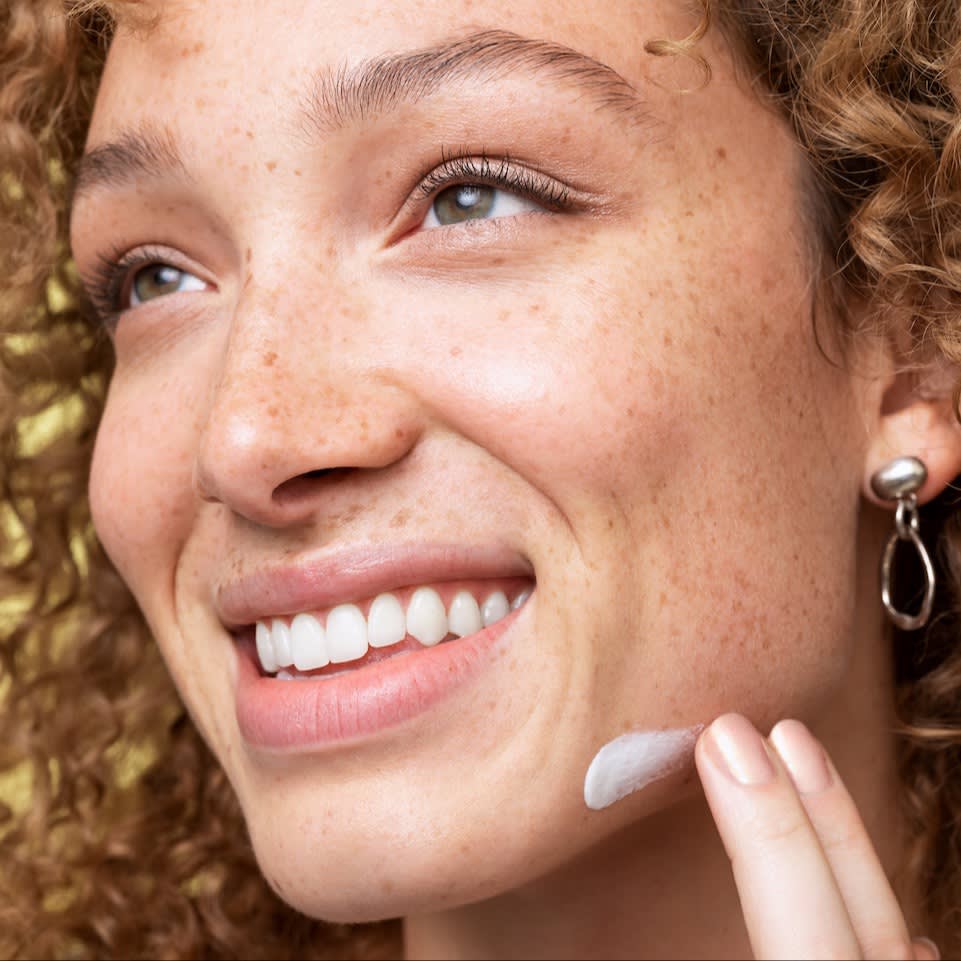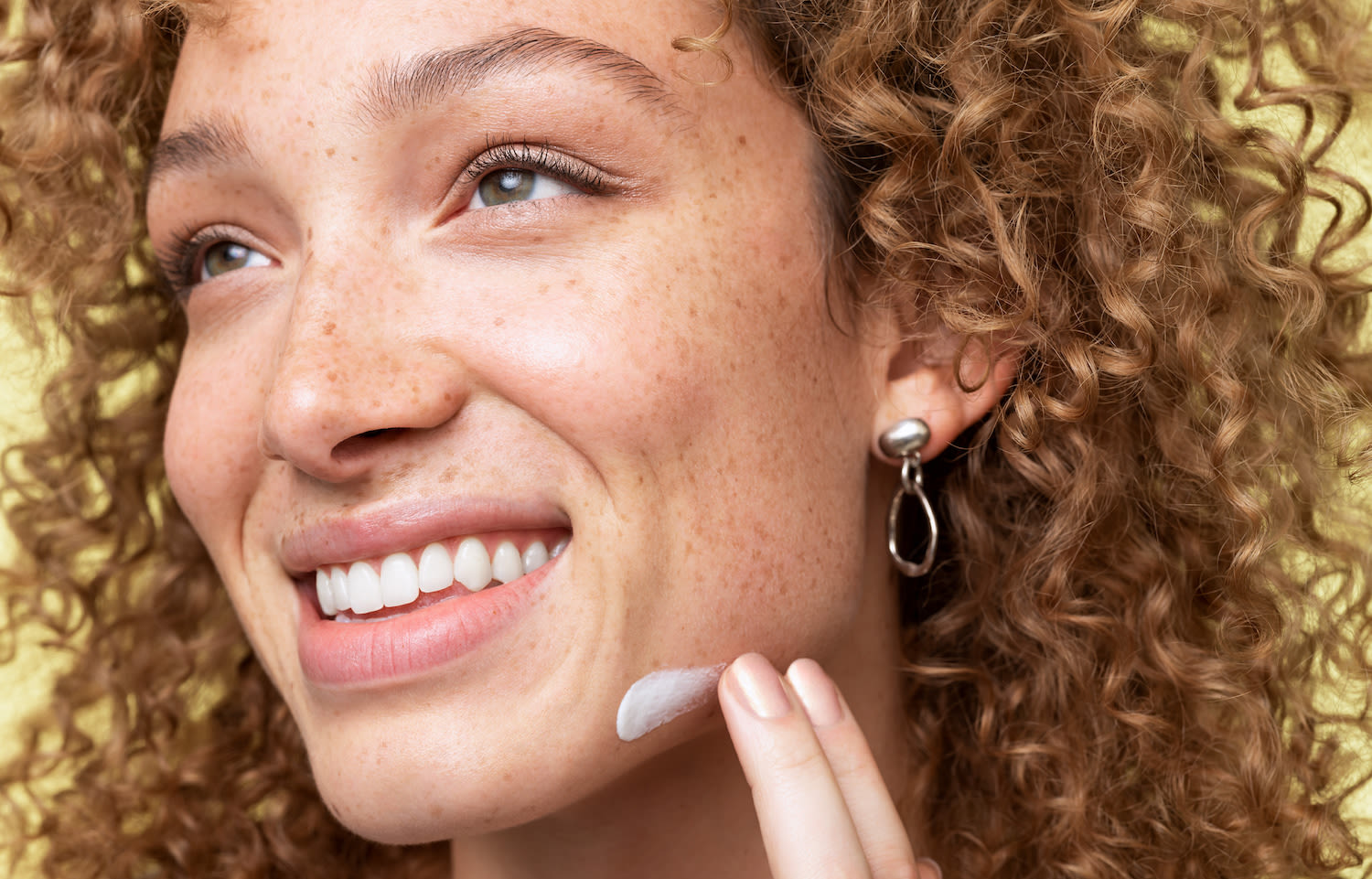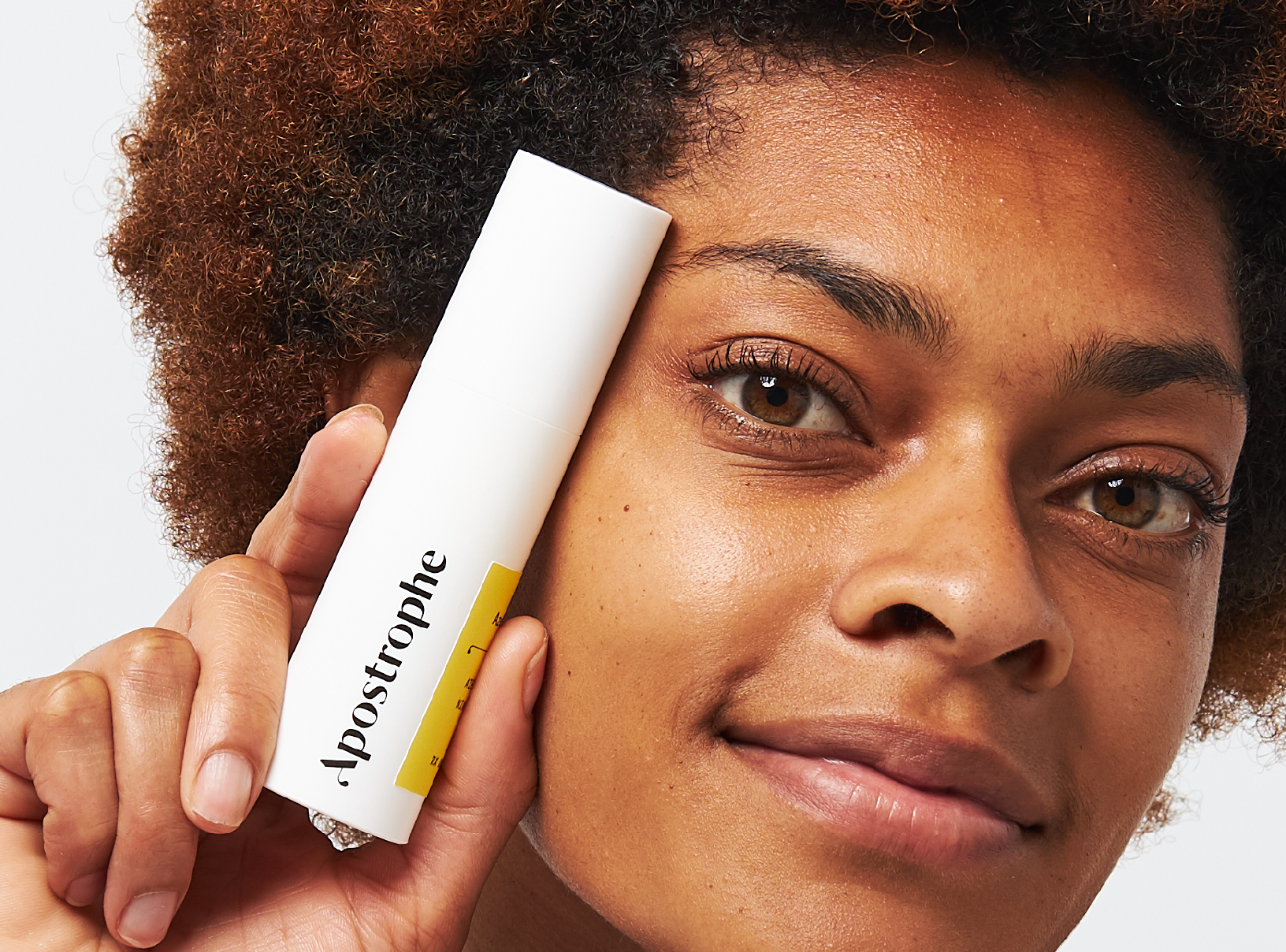Education
The best anti-aging night creams


SHARE
Education
The best anti-aging night creams
Medically reviewed by Katelyn Hagerty FNP
Written by Apostrophe Team
Last updated 11/5/2024
Many important biological processes occur while you’re asleep, including the maintenance and repair of your skin.
Just like the right moisturizer can keep your skin looking smooth and blemish-free during the day, a good quality anti-aging night cream enhances your body’s natural healing abilities and helps to promote optimal skin repair and rejuvenation while you're asleep.
Like with other skin care products, choosing the right anti-aging night cream can be a challenging process.
Luckily, it becomes far easier once you’re aware of how anti-aging creams work, as well as the specific ingredients that help to prevent wrinkles and keep your skin looking its best.
Below, we’ve dug into the science behind anti-aging creams, as well as the skin aging process as a whole.
We’ve also the most effective, science-based ingredients that you should look for when you’re shopping for an overnight treatment or other nighttime anti-aging treatment.
Night Creams: The Basics
As their name suggests, anti-aging night creams are designed for use before you go to bed, either on their own or in combination with other skin care products.
When it comes to night creams, a higher price doesn’t always result in fewer wrinkles or better results. Instead, it’s better to look for science-based ingredients that are proven to make wrinkles, dark spots, and other signs of aging less visible.
Good ingredients to look for in an anti-aging night cream include topical retinoids, alpha and beta-hydroxy acids, vitamins like niacinamide, and moisturizing ingredients such as hyaluronic acid.
Contrary to what advertising campaigns may tell you, there isn’t much evidence to back up the effects of exotic-souding ingredients like plant extracts, fruits, or special oils when it comes to preventing skin aging.
Most anti-aging treatments take several months to start working, meaning you’ll need to be patient and apply your night cream consistently, even if you don’t notice any changes in the beginning. Be patient — it will eventually work.
How Skin Aging Happens
Before we get into more detail on the active ingredients that you should look for in an anti-aging night cream, it’s important to cover the basics of how your skin ages in the first place.
There are two different types of skin aging. The first of these is intrinsic aging. This is a natural, largely unavoidable process that occurs as a result of changes in your skin’s chemical structure as you grow older.
With age, your skin becomes thinner, drier and weaker. New skin cells are created at a slower speed, your skin’s collagen and elastin content declines, and your body’s process of supplying your skin with important nutrients becomes less efficient.
Intrinsic aging is responsible for some of the visible signs of aging you may notice in your skin, such as fine wrinkles. Over time, gravity can make these changes in your skin more visible.
The second type of skin aging is extrinsic aging. This is caused by sun exposure, air pollution, poor nutrition and habits such as smoking. The biggest factor in this type of skin aging, by far, is exposure to UV radiation from strong, intense sunlight.
Preventing skin aging is all about reducing the severity of intrinsic aging, as well as taking steps to prevent or reverse the effects of extrinsic aging.
Choosing the right anti-aging night cream is all about prioritizing ingredients that are proven to treat or prevent aging, all while avoiding ones that aren’t.
For the most part, the active ingredients that you’ll want to look for in a night cream are topical retinoids, peeling agents (exfoliants), moisturizing agents, and vitamins. These work to remove wrinkles and other signs of skin aging from several angles:
Retinoids work by promoting healthy skin cell turnover to keep your skin thick, strong, and flexible throughout your life.
Peeling agents, or exfoliants, work by stripping away the outermost layer of your skin, including dead skin cells that can affect your skin texture and appearance.
Moisturizing agents, or moisturizers, trap water inside your skin and help to maintain a more youthful day-to-day appearance.
Topical vitamins, which help to protect your skin from damage and treat certain signs of aging.
Like with many other skin care products, a high price or beautiful packaging doesn’t necessarily mean that a night cream contains effective ingredients.
To get the best value for money, look for night creams that contain one or several of the types of ingredients listed above. You can learn more about how these ingredients work and their effects on your skin below.
Topical Retinoids
Retinoids are medications derived from vitamin A. They work by stimulating the growth of your skin cells and improving your skin’s ability to renew and rejuvenate itself.
Countless studies have found that retinoids can improve many aspects of skin aging, including wrinkles, dark spots and the skin’s texture and feel.
Used consistently, retinoids can improve your skin’s ability to repair itself and prevent wrinkles and other signs of aging from becoming more visible.
Several topical retinoids are used in night creams and other anti-aging products, including the over-the-counter ingredients retinol and adapalene, and the prescription retinoid tretinoin.

PRESCRIPTION TRETINOIN
Target acne, dark spots, and signs of aging with this science-backed ingredient.
Retinol is a mild retinoid. Research shows that it can thicken the skin (an important benefit, as thick skin is less likely to form into lines) and make the appearance of wrinkles less visible.
Since retinol doesn’t require a prescription, you can find it in many over-the-counter anti-aging night creams, serums and other products.
Adapalene is a synthetic retinoid that’s mostly used to treat acne breakouts, and it’s extremely helpful with acne prone skin. While it has shown some anti-aging benefits in research, it isn’t as widely used for anti-aging purposes as retinol.
Finally, tretinoin is a prescription retinoid. It’s stronger and more effective than retinol. It’s also backed up by the most scientific research of any topical retinoid available.
Tretinoin is very effective at treating deep wrinkles, age spots and other signs of skin aging. Studies also show that it can give the skin a smoother texture and reverse the sagging that often affects skin on the cheeks and around the jawline.
While tretinoin is the most effective topical retinoid, it’s also the most likely to cause issues such as irritated skin and redness, especially during the first few weeks of use.
Tretinoin is an ingredient that could be in your Apostrophe topical treatment, which is available following a consultation with a healthcare provider who will determine if a prescription is appropriate.
Retinoids are effective, but their effects aren’t instant. For example, most research shows that it takes about three months for tretinoin to reduce wrinkles and other signs of aging.
Our full guide to tretinoin vs. retinol vs. retinoids goes into more detail about these ingredients, as well as how they differ from each other.
Peeling Agents
Peeling agents, or exfoliants, work by stripping away the dead skin cells that can build up on the surface of your skin over time.
These cells build up as a result of epidermal turnover — the process of cellular creation that your skin uses to repair itself. By removing this outer layer of dead skin cells, peeling agents promote the growth of new skin that’s less affected by wrinkles and other age-related imperfections.
When it comes to anti-aging night creams, the most common peeling agents are alpha-hydroxy acid (AHAs) and beta-hydroxy acid (BHAs).
Common AHAs include glycolic acid, citric acid, and lactic acid. One of the most well-known and popular BHAs is salicylic acid, which can be found in many topical skin care products.
As well as treating wrinkles and other signs of aging, some peeling agents help to prevent acne by removing skin cells that can clog your pores.
When you’re comparing night creams, serums, or other anti-aging products, check for AHAs and BHAs on the ingredient list.
Our guide to exfoliating acids talks more about the benefits of exfoliating for your skin, as well as the best ways to use peeling agents as part of an anti-aging routine.
Moisturizers
Moisturizing ingredients help your skin retain water, improving your skin barrier function and giving your skin a more youthful appearance.
One of the most popular moisturizing ingredients in night creams and other anti-aging products is hyaluronic acid, a naturally-occurring substance that’s capable of holding significant amounts of moisture inside your skin.
Other popular moisturizing ingredients include petroleum jelly, castor oil, coconut oil, and other natural emollients.
In addition to improving moisture retention, many moisturizing ingredients help to promote the removal of dead skin cells.
Moisturizing ingredients are especially important if you’re prone to dry skin — a common issue with retinoids, peeling agents, and other active ingredients in anti-aging products.
When it comes to moisturizing overnight cream, there’s just one thing to be aware of: some of the oils used in overnight cream can, if you have acne-prone skin, clog your pores and make breakouts worse.
If you have oily skin or sensitive skin that breaks out easily, try to look for night creams that are labeled “oil-free” or “non-comedogenic.” These are designed to offer the benefits of moisturizer without increasing your risk of acne breakouts.
Vitamins
Several vitamins are used in night creams and other anti-aging skin care treatments, including vitamin C and niacinamide (a form of vitamin B3).
Research shows that vitamin C is involved in stimulating the synthesis of collagen, an essential protein that gives your skin its structural integrity. Vitamin C is also used to treat skin pigment issues, such as a form of aging-related skin discoloration called hyperpigmentation.
Niacinamide, or vitamin B3, on the other hand, is linked to improvements in wrinkles, skin tone, and other signs of skin aging in several studies.
We’ve discussed these benefits in more detail in our guide to using niacinamide for better skin.
What Should You Avoid in a Night Cream?
Although many ingredients in skin care offer real, proven benefits, not all are recommended for use before you go to bed.
One ingredient that you should avoid in a night cream, despite its numerous proven benefits for slowing down the effects of aging, is caffeine.
If you’re a coffee drinker, you’re probably already aware of why — caffeine is a strong stimulant, and research shows that when caffeine is applied topically, a modest amount eventually makes its way into your bloodstream.
Other Steps to Prevent Skin Aging
A good night cream — especially one that contains retinoids, peeling agents, and/or moisturizing ingredients such as those above — can make a big difference to the way your skin looks.
However, it’s also to back up good skin care products with equally good habits that protect your skin from sun damage and limit the effects of aging.
To get the most from your anti-aging skin care routine, make sure to:
Protect your skin from the sun. When you’re outside in sunny weather, apply an SPF 30+ sunscreen to any exposed skin. This will help to shield your skin from UV radiation, which is responsible for up to 90 percent of visible, age-related skin changes.
Moisturize during the day too. If you get dry skin during the day, apply a moisturizer to keep your skin hydrated and healthy. Moisturizer is just as important during the day as it is while you’re asleep. Dehydrated skin can lead to a whole slew of problems.
If you smoke, try to quit. Research has found that cigarette smoking can speed up the skin aging process and worsen wrinkles. If you smoke, try to quit for the benefit of your skin and the numerous other aspects of your health affected by smoking.
Aim for seven or more hours of nightly sleep. Your skin repairs itself while you sleep, making it important to spend enough time in bed each night. Aim for at least seven hours of sleep every night — the amount recommended for adults by the CDC.
Be consistent. From retinoids to exfoliants, most anti-aging ingredients require several months to start working. Be patient and keep using your night cream before bed, even if you don’t notice any effects during the first few weeks.
Maintain good skin care habits. There’s more to caring for your skin than just applying a good night cream. Our guide to dermatologist-recommended skin care tips lists proven approaches that you can do to take good all-round care of your skin.
Finding the Best Anti-Aging Night Cream
When it comes to anti-aging night creams, you’ll get the best results by looking for products with proven, science-based, powerful ingredients.
As you’re comparing products, scan the key ingredients labels to check for retinoids, peeling agents, moisturizers, and vitamins such as niacinamide.
Not only are these ingredients safe for your skin, but they’re also backed up by real, high-quality research showing that they can treat wrinkles and other common signs of skin aging.
You can learn more about slowing down the effects of skin aging and protecting your skin in our guide to preventing wrinkles.
References:
Zhang, S. & Duan, E. (2018, May). Fighting against Skin Aging: The Way from Bench to Bedside. Cell Transplantation. 27 (5), 729–738. Retrieved from https://www.ncbi.nlm.nih.gov/pmc/articles/PMC6047276/
Skin Care and Aging. (2017, October 1). Retrieved from https://www.nia.nih.gov/health/skin-care-and-aging
Mukherjee, S., et al. (2006, December). Retinoids in the treatment of skin aging: an overview of clinical efficacy and safety. Clinical Interventions in Aging. 1 (4), 327–348. Retrieved from https://www.ncbi.nlm.nih.gov/pmc/articles/PMC2699641/
Kong, R., et al. (2016, March). A comparative study of the effects of retinol and retinoic acid on histological, molecular, and clinical properties of human skin. Journal of Cosmetic Dermatology. 15 (1), 49-57. Retrieved from https://pubmed.ncbi.nlm.nih.gov/26578346/
11 Ways to Reduce Premature Skin Aging. (n.d.). Retrieved from https://www.aad.org/public/everyday-care/skin-care-secrets/anti-aging/reduce-premature-aging-skin
Harwood, A., Nassereddin, A. & Krishnamurthy, K. (2020, June 2). Moisturizers. StatPearls. Retrieved from https://www.ncbi.nlm.nih.gov/books/NBK545171/
10 Skin Care Habits That Can Worsen Acne. (n.d.). Retrieved from https://www.aad.org/public/diseases/acne/skin-care/habits-stop
Telang, P.S. (2013, April-June). Vitamin C in dermatology. Indian Dermatology Online Journal. 4 (2), 143–146. Retrieved from https://www.ncbi.nlm.nih.gov/pmc/articles/PMC3673383/
Bissett, D.L., Oblong, J.E. & Berge, C.A. (2005, July). Niacinamide: A B vitamin that improves aging facial skin appearance. Dermatologic Surgery. 31 (7 Pt 2), 860-5, discussion 865. Retrieved from https://pubmed.ncbi.nlm.nih.gov/16029679/
Kawada, A., Konishi, N., Oiso, N., Kawara, S. & Date, A. (2008, October). Evaluation of anti-wrinkle effects of a novel cosmetic containing niacinamide. The Journal of Dermatology. 35 (10), 637-42. Retrieved from https://pubmed.ncbi.nlm.nih.gov/19017042/
Trauer, S., et al. (2009, August). Permeation of topically applied caffeine through human skin – a comparison of in vivo and in vitro data. British Journal of Clinical Pharmacology. 68 (2), 181–186. Retrieved from https://www.ncbi.nlm.nih.gov/pmc/articles/PMC2767280/
Photoaging: What You Need to Know About the Other Kind of Aging. (2019, January 10). Retrieved from https://www.skincancer.org/blog/photoaging-what-you-need-to-know/
Seitz, C.M., Strack, R.W. & Wyrick, D.L. (2012, June). Cigarette Smoking and Facial Wrinkles: A Review of the Literature. Journal of Smoking Cessation. 7 (1), 18-24. Retrieved from https://www.cambridge.org/core/journals/journal-of-smoking-cessation/article/abs/cigarette-smoking-and-facial-wrinkles-a-review-of-the-literature/1F8FA1EB004A15BFC70FF9C826055D25
How Much Sleep Do I Need? (2017, March 2). Retrieved from https://www.cdc.gov/sleep/about_sleep/how_much_sleep.html
Like what you just read? Sign up for our email list to get the scoop on skincare science delivered straight to your inbox.

Deep Dives
A dermatologist shares his thoughts on the recent studies about benzoyl peroxide and benzene.
Read More
Education
What is milia?
What is milia? Today, we’re jumping into one type of bump that you may have heard about most commonly in infants — milia.
Read More
Education
Best moisturizer for acne-prone skin
If you have combination acne-prone skin, figuring out which moisturizer is best for your skin might be tough. In this guide, we break down the best moisturizer for combination, acne-prone skin.
Read More